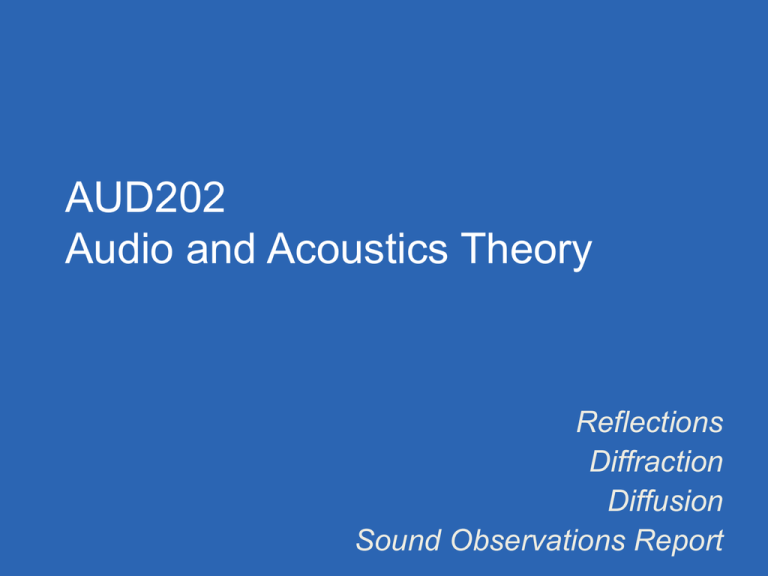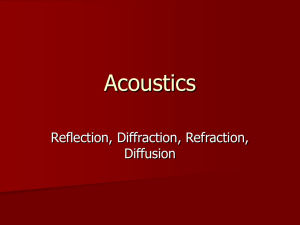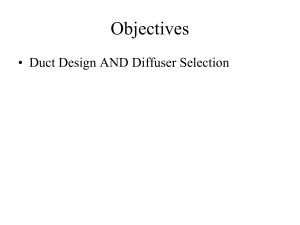Week 9 - Truth Recordings
advertisement

AUD202 Audio and Acoustics Theory Reflections Diffraction Diffusion Sound Observations Report Last Week > The Doppler Effect Delay Perception SPL Meters Upcoming Events 18 Days - Sound Observations Report 28 Days - Exam Topics So Far The Decibel Sound Properties White and Pink Noise Wavelength Envelope of Sound Frequency Anatomy of the Ear Amplitude Hearing Protection Period OH&S principles Comb Filtering SPL Meters Speed of Sound NIHL Wave Interaction Phase Concepts Standing Waves The Inverse Square Law Harmonics and Overtones Psychoacoustics Waveforms Masking Reflection Diffraction Diffusion Haas Effect Doppler Effect Delay Perception Beat Frequencies Loudness Curves Ranges of Hearing Delay Perception up to 10ms – comb filtering effects from wave interaction 10-40ms – a ‘thickening’ effect 40ms and over – a distinct repeat or echo of the sound COMB FILTERING Comb Filtering When a delayed version of a sound interacts with the original sound causing constructive and destructive interference Write down three situations where this could occur Comb Filtering If two identical signals are shifted against each other in time some frequencies will be cancelled and some will be reinforced Odd harmonics of the fundamental frequency of cancellation will cancel Even harmonics of the fundamental frequency of cancellation will reinforce Comb Filtering How to Calculate the fundamental frequency of cancellation of a comb filter: Find the longest wavelength that can occur between two points (a 2m room will have a 4m wavelength), from that find the frequency of the full wavelength. This is your fundamental frequency of cancellation. Comb Filtering Given the following room length axis measurements, calculate the fundamental frequency of cancellation 5 meters 7 meters 1 meter Comb Filtering Remembering that odd harmonics cancel and even harmonics reinforce, what are the first 3 cancellations for the following fundamental frequencies: 100Hz 2500Hz 600Hz REFLECTION Reflection Sound acoustics is the field primarily concerned with the reflections of sound. Reflected sound reveals the size and materials within a space. Changing the size or materials will alter the quality and amount of reflections. Reflection Direct sound is the original sound Early Reflections are the first reflections you hear after the direct signal. Direct Sound vs. Reflected Sound Reflection The diffuse field is where the reflected sound is higher in level than the direct sound. The near field is where the direct sound is the louder. Reflections Sound bounces off reflective surfaces in the same behaviour as light – and follows the law "angle of incidence equals angle of reflection" Reflections Reflected waves can interfere with incident waves, producing constructive and destructive interference which can result in standing waves Standing Waves What can be done to combat standing waves? Reflections Reflection from a HARD boundary Reflections Reflection from a HARD boundary DIFFRACTION Diffraction Diffraction is the bending of waves around small obstacles and the spreading out of waves beyond small openings. Diffraction Diffraction When sound passes through a hole in a barrier, the hole becomes a new ‘point source’ and the sound will spread out from that point. DIFFUSION Diffusion In acoustics, diffusion is the scattering of sound waves to reflect them in different directions. Or breaking the soundwaves into smaller pieces. Diffusion is commonly used to reduce specular reflections and echo. Also to direct sound energy to specific areas. Diffusers The purpose of a diffuser is to break up sound waves and disperse them in various directions. There are two main types of diffuser, the barrel diffuser and the quadratic diffuser. Adding sound diffusion to your acoustic room treatment can improve the speech and instrument intelligibility and improve the overall listening environment within the room Barrel Diffusers Quadratic Diffusers Quadratic Diffusers SPL METERS SPL Meters A weighting is based on the human perception of loudness (e.g. the equal loudness curves) and is used for most situations. SPL Meters C weighting provides a flatter response and is useful for peak sound analysis Next Week > Reverberation Parameters and Concepts Absorption Co-Efficients











